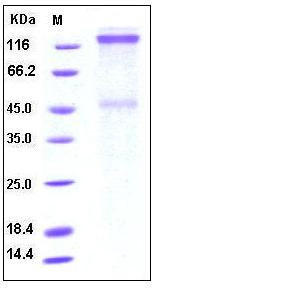Human IGF1R / CD221 Protein (His Tag)
CD221,IGF-I R,IGFIR,IGFR,JTK13
- 100ug (NPP3986) Please inquiry
| Catalog Number | P10164-H08H |
|---|---|
| Organism Species | Human |
| Host | Human Cells |
| Synonyms | CD221,IGF-I R,IGFIR,IGFR,JTK13 |
| Molecular Weight | The calculated molecular masses for α subunit, β subunit and the single chain of the receptor are approximately 81 kDa, 23 kDa and 104 kDa, respectively. As a result of glycosylation, the recombinant single chain, α subunit and β subunit have apparent molecular masses of approximately 150 kDa, 120 kDa and 48 kDa, respectively in SDS-PAGE under reducing conditions. |
| predicted N | Glu 31 |
| SDS-PAGE |  |
| Purity | > 90 % as determined by SDS-PAGE |
| Protein Construction | A DNA sequence encoding the extracellular domain (Met 1-Asn 932) of human IGF1 Receptor (NP_000866.1) precursor was expressed with a C-terminal polyhistidine tag. |
| Bio-activity | Measured by its ability to bind biotinylated human IGF1 in a functional ELISA. |
| Research Area | Developmental Biology |Post embryonic development |Cellular Senescence & Aging |GH/IGF-I Axis |
| Formulation | Lyophilized from sterile PBS Buffer, pH 7.4 1. Normally 5 % - 8 % trehalose and mannitol are added as protectants before lyophilization. Specific concentrations are included in the hardcopy of COA. |
| Background | The insulin-like growth factor-1 receptor (IGF1R) is a transmembrane tyrosine kinase involved in several biological processes including cell proliferation, differentiation, DNA repair, and cell survival. This a disulfide-linked heterotetrameric transmembrane protein consisting of two α and two β subunits, and among which, the α subunit is extracellular while the β subunit has an extracellular domain, a transmembrane domain and a cytoplasmic tyrosine kinase domain. IGF1R signalling pathway is activated in the mammalian nervous system from early developmental stages. Its major effect on developing neural cells is to promote their growth and survival. This pathway can integrate its action with signalling pathways of growth and morphogenetic factors that induce cell fate specification and selective expansion of specified neural cell subsets. Modulation of cell migration is another possible role that IGF1R activation may play in neurogenesis. In the mature brain, IGF-I binding sites have been found in different regions of the brain, and multiple reports confirmed a strong neuroprotective action of the IGF-IR against different pro-apoptotic insults. IGF1R is an important signaling molecule in cancer cells and plays an essential role in the establishment and maintenance of the transformed phenotype. Inhibition of IGF1R signaling thus appears to be a promising strategy to interfere with the growth and survival of cancer cells. IGF1R is frequently overexpressed by tumours, and mediates proliferation and apoptosis protection. IGF signalling also influences hypoxia signalling, protease secretion, tumour cell motility and adhesion, and thus can affect the propensity for invasion and metastasis. Therefore, the IGF1R is now an attractive anti-cancer treatment target. |
| Reference |
